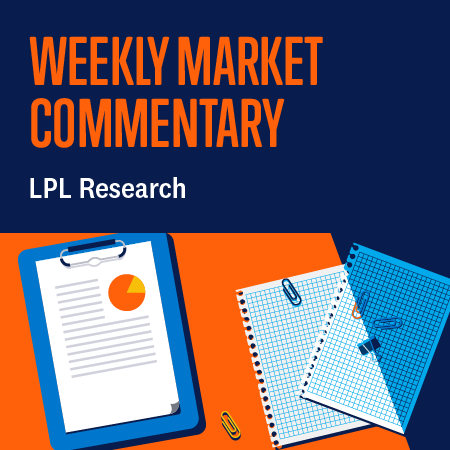As the new year officially gets underway, there’s the usual sense of renewed optimism and excitement over new opportunities. However, recent stock market activity is casting a shadow over this sentiment. Momentum in equity markets has recently stalled, and breadth measures have deteriorated, suggesting the recent pullback might not be over. The silver lining to a deeper drawdown is that it could provide a buying opportunity back into this bull market, as most importantly, the S&P 500 remains above its longer-term uptrend, and fundamentals are on solid footing. The economy is holding up well; corporate earnings continue to grow at a strong pace; the Federal Reserve (Fed) is likely to cut rates further this year; and the incoming administration could deliver a pro-growth agenda with less regulation and lower taxes. And while higher rates and the potential for re-accelerating inflation remain key risks in the year ahead, we still believe this bull market deserves the benefit of the doubt.
With 2024 fully behind us, it’s a good time to celebrate our winning calls from last year while also reviewing some mistakes to learn from them and improve our process. The good news is we got more right than wrong last year, but there were some misses. Some course corrections helped. Perhaps the most impactful decision we made was to recommend investors stay fully invested in equities at benchmark levels throughout the entire year despite expecting a stock market pullback around Election Day.
LPL Research’s Outlook 2025: Pragmatic Optimism will be released tomorrow and available on LPL.com. Here we just provide an appetizer before the main course and share some of the stock and bond market themes covered in the full publication.
The dollar’s continued climb higher has been predicated on a host of factors — including the rise in geopolitical risk and the dollar’s safe haven status as inflows have picked up markedly, uncertainty with regard to the Federal Reserve’s (Fed) interest rate move in December, a solid domestic economic landscape with inflation still “sticky,” a weakening euro as expectations suggest the potential for a stronger rate cut, and questions regarding the inflationary implications of the Trump administration’s tariff agenda. With more questions than answers, the dollar’s ascent is expected to continue — or level off — until there’s more definitive information regarding the extent of tariffs, and on the other side of the equation, the effect of retaliatory tariffs. Global capital markets seek clarity, particularly the currency market.
It’s a Whole New World
One of the biggest fears for investors right now is the resurgence of inflation from adverse effects of Trump’s potential trade policy. Also worth mentioning, general market uncertainty is building, thanks to an over-eager Federal Reserve (Fed) who did a super-size jumbo cut in September, paving the way for markets to be disoriented about the Fed’s future path.
The clouds of uncertainty parted last week as former President Donald Trump decisively won the U.S. election, making him the second U.S. president to win non-consecutive terms (Grover Cleveland was the first to do it back in 1892). Investors welcomed the news with renewed risk appetite, bidding the S&P 500 to its 50th record high of the year on Friday. Trump’s proposed economic policies, including deregulation, a likely extension of the 2017 tax cuts, a possible corporate tax rate cut, and proposed tax exemptions on tips, social security, and overtime pay helped underpin buyer enthusiasm. The immediate de-risking of when the election will be decided was another big factor behind the post-Election Day rally.
Stocks were not the only asset class on the move last week, as Treasury yields and the dollar also advanced. Growth expectations re-rated higher as the market priced in more economic-friendly policy proposals. However, the improving growth outlook was accompanied by concerns over the deficit and rising inflation, especially with Trump’s proposed tariff policies. Herein, we discuss these themes and other major election takeaways for investors.
As Election Day approaches, we discuss potential stock market implications of various possible outcomes. But before we get into that, we offer our regular public service announcement around elections and investing. Political views are best expressed at the polls and not in portfolios.
Stocks have fared well under Democrats and Republicans, in unified and divided government, and in polarizing political environments. Capitalism and corporate profits drive markets more than politics. Narrow majorities in Congress take out extremes, helping to mitigate the risk that bad economic policy substantially weakens the U.S. economy. Geopolitical threats are serious, no doubt, and can disrupt the U.S. economy temporarily, but our economy and financial markets are incredibly resilient.
Stocks have done so well this year that it’s fair to say market participants haven’t feared much. But just because risks haven’t affected markets lately doesn’t mean they won’t in the future. In that “spirit,” as Halloween approaches, we discuss what scares us about the economy and financial markets.
The Bear Gives Way to the Bull
On October 12, 2022, there were very few comments suggesting that a new bull market was in the throes of being born as the S&P 500 opened at 3,590.83 and closed at 3,577.03.
Federal Reserve Chair Jerome Powell said last month’s decision to cut the fed funds target rate by a half percentage point was due to a “recalibrating” policy, as the Fed follows its dual mandate regarding inflation and growth.
The new buzzword — recalibration — implies mechanical fine-tuning, but unfortunately, the macro economy is not that robotic. We are full of emotional people with ever-changing needs and wants. However, the buzzword also evokes something therapeutic; that is, the Fed is not cutting rates because of an imminent recession. In fact, the economy will likely grow above trend for yet another quarter or two. However, risks are rising for 2025.
When it comes to investing, gold may be the antithesis of artificial intelligence (AI). The precious metal has acted as a store of value for thousands of years with zero technological innovation — gold is discovered, not developed. Gold is also a real tangible asset and can act as a potential hedge against inflation or a safe haven during times of crisis. Given these properties and the backdrop of a risk-on-record-setting equity market, many investors are wondering what’s behind the paradoxical price action of gold’s rally to new highs and how the yellow metal has matched the momentum in AI stocks over the last several months (gold and the equal-weight Magnificent Seven Index are both up around 20% since March). Herein we discuss the key drivers of gold and why this rally is no flash in the pan.
Of course, last week’s headliner was Jerome Powell and the Federal Reserve (Fed) cutting rates by a half percent on Wednesday, September 18, the first time since the COVID-19 pandemic broke out in 2020. The Fed “pause” ended at 423 days and now stands as the second-longest on record, while the 26% gain for the S&P 500 during the pause (7/27/23–9/18/24) ranks first. Here we share some thoughts on the Fed’s move last week and some potential market implications of not only Fed policy but also fiscal policy post-election.


